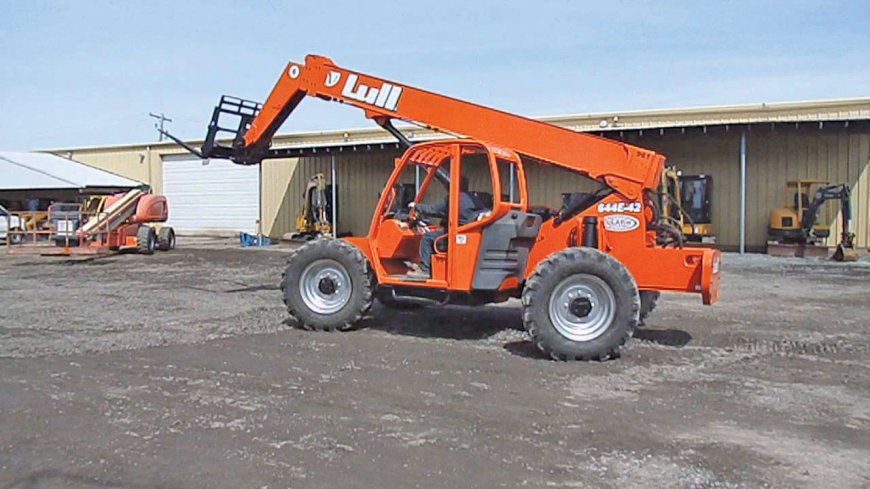The Provenance of Telehandlers!
The telescopic handler is a multi-use piece of equipment that can be found under many names. Also called a telehandler, teleporter, reach forklift,

Originally called the “telescopic forklift” the very first telehandler was created in 1977: the JCB 520 Loadall Telehandler, finds Equipment Times.
The telescopic handler is a multi-use piece of equipment that can be found under many names. Also called a telehandler, teleporter, reach forklift, boom lift, lull or cherry picker, the telehandler is often used in agriculture to move hay and hay bales. Mainly used in agriculture the telehandler is growing in popularity outside of the agriculture industries and are now seen on construction sites and manufacturing plants among others. They can be used for a variety of jobs including moving heavy loads off of trucks, cleaning up sites, moving materials and plowing snow.
The Basics of a Telehandler
A hybrid crane forklift, a telehandler can also be fitted with other attachments like a bucket, muck grab, or winch. It can also be fitted with a platform attachment to act as a boom-lift.
The extendable boom on a telehandler can usually be elevated at a 70-degree angle and extend out as far as 30 feet or further. The max weight restriction of an individual telehandler is determined by a mix of factors including boom extension, angle, the type of attachment and wind speed.
Telehandlers have a maximum lift capacity ranging from 4,400 to 12,000 lbs, depending on the size of the equipment. However maximum lift capability cannot be reached at maximum reach and should always be used with care.
Common Uses of Telehandlers
The telehandler is a truly versatile piece of equipment. The extendable boom and ability to use a variety of attachments gives the telehandler many different applications.
Primarily used as a “lift and place” tool, the telehandler is seen as a more advanced forklift since it has a greater extension ability than a traditional forklift.
It can be fitted with pallet forks, a bucket, lifting jibs, sweeper and work platforms. With so many different attachments, telehandlers can help perform jobs like lifting and moving material, moving loads of earth, cleaning worksites, lifting workers to an aerial height or even snow removal.
Attachments for The Telehandler
Forks are the most common attachment for a telehandler as the boom allows for easy lifting of materials and cargo from the ground up to aerial heights. Compact or midsize telehandlers can be used indoors to move and transport items in warehouses or manufacturing plants. The application of a platform attachment can make it easier for warehouse workers to work at heights if a boom or scissor aerial lift isn’t an option.
Forklift and bucket attachments are available in a variety of shapes and sizes to allow for easy scooping, loading, lifting, and moving of material from the ground to a loft or to load into a truck. These applications are helpful in both construction and agriculture.
Telehandlers have applications for all four seasons. In the winter telehandlers can be used for snow removal. Since the machine sits very low to the ground they are great for plowing snow in parking structures. Traditional tractors or even trucks can be too big for certain areas making the telehandler a great tool or snow removal. Metal Pless is a brand of snowplows that can be used for telehandlers.
The Lull Telehandler
The Lull telehandler was created in 1959 by Legrand “shorty” Lull in Minnesota. His company became Lull Engineering Inc in 1963, then was acquired by Stamatakis Industries before declaring bankruptcy in 1992.
At this time it was purchased and owned by a man named Badger Bazen from Johnsonville, S.C. who changed the name to Lull Industries and finally Lull International. Over the next few years the Lull name was passed around some more, joining The Harbour Group of St Louis in 1996 which made it a division of SkyTak. In 2003, after a few more company ownership shuffles, JLG acquired the Lull name and used the brand recognition to lead the way for the North American telehandler market.
Despite the many twists and turns that the Lull name has seen it grew to become a recognized brand name for a telehandler. In fact it has been used synonymously for the term “telehandler” and some people refer to the machine simply as a “lull”.
A division of JLG, the Lull telehandler line is on its way to extinction. JLG had announced in 2014 that they would cease all production of Lull telehandlers in 2015 but would continue to service Lull telehandlers beyond that time. This decision was made in response to a market decline for Lull telehandler models and increased EPA (Environmental Protection Agency) engine standards.
The Lull models of telehandler are the Lull 644E-42, 944E-42 and 1044C-45 Series II.
The History of the Telehandler
Originally called the “telescopic forklift” the very first telehandler was created in 1977: the JCB 520 Loadall Telehandler. The 520 was a two-wheel drive machine which combined the forklift, crane and backhoe into one Frankenstein machine. The industry was blown away and it became very popular very quickly. Within a year JCB introduced a four-wheel version of the machine with a number of other attachment types.
A number of other brands began manufacturing their own telehandler machines such as CAT, JLG and Bobcat. Modern telehandlers are able to reach up to 65 feet in the air and carry more than 20,000 lbs. They are now being recognized for their diversity in manufacturing and construction. More recently telehandlers have been seen as a tool for snow removal.
With the construction industry prioritizing project efficiency the value of the telehandler is on the rise.
www.dozr.com
Hits: 109








